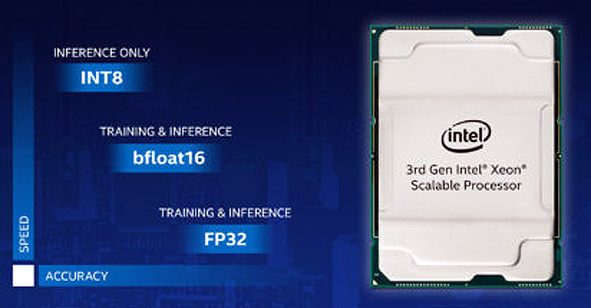Intel Xeon processors attack AI and edge applications
- June 24, 2020
- Steve Rogerson

Intel has introduced its third-generation Xeon scalable processors and additions to its hardware and software artificial intelligence (AI) portfolio so designers can accelerate the development and use of AI and analytics in data centre, network and intelligent-edge environments.
As the industry’s first mainstream server processor with built-in BFloat 16 support, the processors makes AI inference and training more widely deployable on general-purpose CPUs for applications that include image classification, recommendation engines, speech recognition and language modelling.
“The ability to rapidly deploy AI and data analytics is essential for today’s businesses,” said Lisa Spelman, Intel corporate vice president. “We remain committed to enhancing built-in AI acceleration and software optimisations within the processor that powers the world’s data centre and edge solutions, as well as delivering an unmatched silicon foundation to unleash insight from data.”
AI and analytics open opportunities for users across a broad range of industries, including finance, healthcare, industrial, telecoms and transportation. IDC predicts that by 2021, 75% of commercial enterprise apps will use AI. And by 2025, IDC estimates that roughly a quarter of all data generated will be created in real time, with various IoT devices creating 95% of that volume growth.
Intel’s data platforms, coupled with an ecosystem of partners using Intel AI technologies, are optimised for businesses to monetise their data through the deployment of intelligent AI and analytics services.
Intel is extending its investment in built-in AI acceleration in the Xeon processors through the integration of BFloat 16 support into the processor’s DL Boost technology. BFloat 16 is a compact numeric format that uses half the bits as today’s FP32 format but achieves comparable model accuracy with few if any software changes required. The addition of BFloat 16 support accelerates AI training and inference performance in the CPU.
Intel-optimised distributions for deep learning frameworks, including TensorFlow and Pytorch, support BFloat 16 and are available through the Intel AI Analytics toolkit. Intel also delivers BFloat 16 optimisations into its Open Vino toolkit and the Onnx Runtime environment to ease inference deployments.
The latest Xeon processors code-named Cooper Lake evolve Intel’s four- and eight-socket processor offering. The processor is designed for deep learning, virtual machine (VM) density, in-memory database, mission-critical applications and analytics-intensive workloads. Users refreshing aging infrastructure can expect an average estimated gain of 1.9 times on popular workloads and up to 2.2 times more VMs compared with five-year-old four-socket platform equivalents.
As part of the platform, the company also announced the Optane persistent memory 200 series, providing up to 4.5Tbyte of memory per socket to manage data intensive workloads, such as in-memory databases, dense virtualisation, analytics and high-powered computing.
For systems that store data in all-flash arrays, Intel announced the availability of its latest 3D NAND SSDs, the SSD D7-P5500 and P5600. These are built with triple-level cell 3D NAND technology and a low-latency PCIe controller to meet the intense IO requirements of AI and analytics workloads and features to improve IT efficiency and data security.
Intel has also disclosed its upcoming Stratix 10 NX FPGAs that are AI-optimised for high-bandwidth, low-latency AI acceleration. These FPGAs will offer customisable, reconfigurable and scalable AI acceleration for compute-demanding applications such as natural language processing and fraud detection. The FPGAs include integrated high-bandwidth memory, networking capabilities and AI-optimised arithmetic blocks called AI Tensor Blocks, which contain dense arrays of lower-precision multipliers typically used for AI model arithmetic
As Intel expands its AI portfolio, it is also paving the way to simplify heterogeneous programming for developers with its One API cross-architecture tools to accelerate performance and increase productivity. With these tools, developers can accelerate AI workloads across Intel CPUs, GPUs and FPGAs, and future-proof their code for today’s and the next generations of Intel processors and accelerators.
Intel has enhanced its Select Solutions portfolio to accelerate deployment of IT’s urgent requirements highlighting the value of pre-verified product delivery in today’s rapidly evolving business climate. There are three new and five enhanced Select Solutions focused on analytics, AI and hyper-converged infrastructure. The enhanced Select Solution for genomics analytics is being used to find a vaccine for Covid-19 and the Select Solution for VMware Horizon VDI on vSAN is being used to enhance remote learning.
The third-generation Xeon scalable processors and Optane persistent memory 200 series are shipping today. In May, Facebook announced that the processors would be the foundation for its open compute platform (OCP) servers, and other CSPs, including Alibaba, Baidu and Tencent, have announced they are adopting the processors.
General OEM systems availability is expected in the second half of 2020. The SSD D7-P5500 and P5600 3D NAND SSDs are available today. And the Stratix 10 NX FPGA is expected to be available in the second half of 2020.




